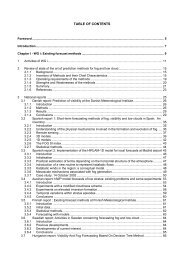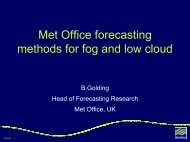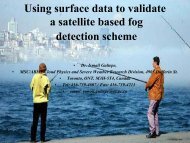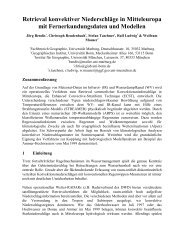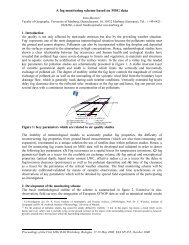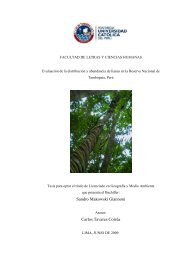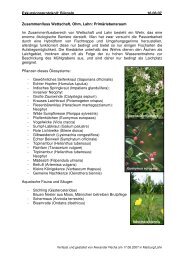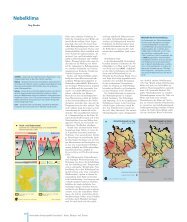Met Office Unified Model NIMROD Nowcasting - LCRS
Met Office Unified Model NIMROD Nowcasting - LCRS
Met Office Unified Model NIMROD Nowcasting - LCRS
Create successful ePaper yourself
Turn your PDF publications into a flip-book with our unique Google optimized e-Paper software.
1 Rachel Capon 04/2004 © Crown copyright<br />
<strong>Met</strong> <strong>Office</strong> <strong>Unified</strong> <strong>Model</strong><br />
<strong>NIMROD</strong> <strong>Nowcasting</strong><br />
Rachel Capon<br />
<strong>Met</strong> <strong>Office</strong> JCMM
<strong>Unified</strong> <strong>Model</strong> 5.+, 6.+<br />
– New Dynamics Core<br />
2 Rachel Capon COST 722 Paris 25/06/2004 © Crown copyright<br />
Outline<br />
– Physical Parametrisations<br />
– Limited Area Configuration<br />
Single Column <strong>Unified</strong> <strong>Model</strong><br />
Site Specific Forecast <strong>Model</strong><br />
Nimrod <strong>Nowcasting</strong> System
3 Rachel Capon COST 722 Paris 25/06/2004 © Crown copyright<br />
New Dynamical Core<br />
OLD formulation<br />
Eulerian 4 th order advection<br />
Split-explicit time integration<br />
Horizontal B grid<br />
Vertical staggering – Lorenz<br />
Sigma pressure coordinate<br />
Quasi-hydrostatic formulation<br />
<strong>Unified</strong> <strong>Model</strong> 5.x<br />
operational since Aug 2002<br />
NEW formulation<br />
Semi-Lagrangian advection<br />
Semi-implicit time integration<br />
Horizontal C grid<br />
Vertical – Charney-Phillips<br />
Hybrid height coordinate<br />
Non-hydrostatic formulation
Fully-compressible deep atmosphere<br />
equns<br />
Du r uvtanφ 1 ∂p<br />
⎛uw ⎞<br />
− −2Ω sinφv+<br />
= − ⎜ + 2Ωcosφw⎟ F<br />
Dt r ρrcosφ λ ⎝ r<br />
⎠ +<br />
∂<br />
2<br />
D r v u tan φ<br />
1 ∂ p ⎛ vw ⎞<br />
+ + 2Ω sin φ u + = − ⎜ ⎟ + F v<br />
Dt r ρ r ∂ φ ⎝ r ⎠<br />
{ D w}<br />
1 ∂p∂Φ Dt ρ ∂ r { ∂ r<br />
r<br />
+ + =<br />
Dr<br />
ρ<br />
+ ρ∇⋅<br />
r u=<br />
0<br />
Dt<br />
≈<br />
4 Rachel Capon COST 722 Paris 25/06/2004 © Crown copyright<br />
g<br />
2 2 ( u + v )<br />
r<br />
r D Fθ<br />
+ 2Ωcosφu + F<br />
θ<br />
= p = ρRT<br />
Dt<br />
w<br />
u<br />
( ) ( 2<br />
vcosφ<br />
∂ r w)<br />
D ∂ u ∂ v ∂ ∂ 1 ⎛∂u ∂ ⎞ 1<br />
= + + + w , ∇ ⋅ u=<br />
+ +<br />
D cosφ λ φ cosφ⎝<br />
λ φ ⎠<br />
r<br />
r<br />
2<br />
t ∂t r ∂ r∂ ∂r r<br />
⎜<br />
∂ ∂<br />
⎟<br />
r ∂r
5 Rachel Capon COST 722 Paris 25/06/2004 © Crown copyright<br />
<strong>Unified</strong> <strong>Model</strong> Dynamics<br />
What’s ‘New’<br />
Fully compressible, non-hydrostatic, deep atmosphere.<br />
– Universal application (Climate to microscale)<br />
Semi-Lagrangian, Semi Implicit solution.<br />
Du t+ dt t t+ dt t<br />
= Forcing → u = ud + αForcing + (1 −α)<br />
Forcing d<br />
Dt<br />
ud is value at departure point, found by high<br />
order interpolation.<br />
No stability limit on timestep. No additional<br />
diffusion required.
6 Rachel Capon COST 722 Paris 25/06/2004 © Crown copyright<br />
<strong>Unified</strong> <strong>Model</strong> Dynamics<br />
What’s ‘New’<br />
Terrain following height based vertical coordinate<br />
– r(i,j,k) specified<br />
Arwakawa C Grid in horizontal (not B)<br />
– No averaging of pressure gradient<br />
– No grid decoupling<br />
– Better geostrophic adjustment for short waves<br />
Charney-Philips Grid in vertical<br />
– No computational modes<br />
– More consistent with thermal wind balance<br />
w,,q<br />
u v<br />
,⌫(p)<br />
– Can have complications in coupling with boundary layer parametrisation<br />
y<br />
x
7 Rachel Capon COST 722 Paris 25/06/2004 © Crown copyright<br />
Physical Parametrisations<br />
Edwards-Slingo Radiation<br />
– (Edwards & Slingo 1996)<br />
Mixed phase precipitation<br />
– (Wilson & Ballard 1999)<br />
– Extending to prognostic cloud fraction (Wilson, Bushell)<br />
– Extending to prognostic cloud water, rain water, ice, snow, graupel (Forbes)<br />
<strong>Met</strong> <strong>Office</strong> Surface Exchange Scheme (MOSES I and II)<br />
– (Cox, Essery, Betts)<br />
Non-local Boundary Layer<br />
– (Lock et al 2000)<br />
New GWD scheme + GLOBE orography, smoothed (Raymond<br />
filter)<br />
Mass flux convection scheme with CAPE closure, downdraft and<br />
momentum transport, separate shallow cumulus<br />
– (Gregory and Rowntree, Kershaw, Grant)
8 Rachel Capon COST 722 Paris 25/06/2004 © Crown copyright<br />
Microphysical parametrisation<br />
Complexity vs. Efficiency<br />
Operational <strong>Unified</strong> <strong>Model</strong><br />
Wilson and Ballard (1999)<br />
“Cloud Resolving” <strong>Model</strong>s<br />
Enhanced Microphysics
Treats heterogeneous surfaces<br />
using ‘blending height’ techniques<br />
and tiles.<br />
Surface exchange from each surface<br />
type treated separately<br />
Nine surface types,<br />
– Broad Leaf Trees<br />
– Needle Leaf Trees<br />
– C3 Grass<br />
– C4 Grass<br />
– Shrub<br />
– Urban<br />
– Water<br />
– Soil<br />
– Ice<br />
Each tile has fixed characteristics.<br />
4 layer soil temperature and<br />
moisture.<br />
9 Rachel Capon COST 722 Paris 25/06/2004 © Crown copyright<br />
MOSES II<br />
Blending Height<br />
Surface
10 Rachel Capon COST 722 Paris 25/06/2004 © Crown copyright<br />
Tiles surface exchange<br />
Each tile has a full surface<br />
energy balance.<br />
This includes a radiatively<br />
coupled ‘canopy’. In the<br />
urban case this has high<br />
thermal inertia to simulate<br />
wall effects.<br />
Work in progress<br />
(Harman, Belcher, Best)<br />
to improve urban<br />
representaion.<br />
R N<br />
H λE ε s σ T s 4<br />
ε g σ T g 4<br />
G<br />
ε s σ T s 4
11 Rachel Capon COST 722 Paris 25/06/2004 © Crown copyright<br />
Boundary Layer Scheme<br />
First order, moist<br />
Allows for non-local mixing in unstable regimes (top<br />
down/bottom up)<br />
Scheme diagnoses 6 different mixing regimes in<br />
order to represent stable, well mixed and cumulus<br />
and stratocumulus processes<br />
Scheme includes boundary layer top entrainment<br />
parametrisation. Especially well suited for stratocumulus.<br />
Improved interaction with the convection scheme<br />
New non-local stable scheme
12 Rachel Capon COST 722 Paris 25/06/2004 © Crown copyright<br />
NWP <strong>Model</strong> Domains<br />
Research Configuration<br />
Horizontal Vertical (lowest km)
13 Rachel Capon COST 722 Paris 25/06/2004 © Crown copyright<br />
NWP <strong>Model</strong> Orography<br />
12 km 4 km 1 km
14 Rachel Capon COST 722 Paris 25/06/2004 © Crown copyright<br />
Single Column <strong>Unified</strong> <strong>Model</strong><br />
1D column version with full physics<br />
Choice of forcing<br />
– Observational<br />
– Statistical<br />
– Fixed
15 Rachel Capon COST 722 Paris 25/06/2004 © Crown copyright<br />
Site Specific Forecast <strong>Model</strong><br />
1D (semi-)automated model based on<br />
UM “physics” - full column<br />
Greatly increased resolution in BL & soil<br />
“Dynamics”=“Forcing data”: grad p,<br />
advection, etc.<br />
Simple forcing correction for orography<br />
MOSES with tile surface exchange for<br />
separate treatment of land use types<br />
Radiative canopy coupled to surface<br />
exchange<br />
Upwind satellite derived land-use<br />
determines drag & surface fluxes of<br />
heat, moisture<br />
Surface landuse weighting via a stability<br />
dependent Source Area <strong>Model</strong>
16 Rachel Capon 04/2004 © Crown copyright<br />
<strong>NIMROD</strong> <strong>Nowcasting</strong> System<br />
Rod Brown, Stephen Moseley<br />
Input<br />
– radar + satellite data<br />
– SYNOPS<br />
– Mesoscale model forecasts<br />
– Sferics<br />
Output includes<br />
Visibility, T, Td, total water, liquid water<br />
temp, fog probability (200m, 1km, 5km),<br />
relative humidity
<strong>Model</strong> T<br />
and T d<br />
<strong>Model</strong> Aerosol<br />
concentration<br />
17 Rachel Capon COST 722 Paris 25/06/2004 © Crown copyright<br />
Visibility Analysis<br />
Visibility<br />
Analysis<br />
Satellite data<br />
Synops
18 Rachel Capon COST 722 Paris 25/06/2004 © Crown copyright<br />
Visibility Forecast<br />
Initial analysis from satellite data and SYNOPs<br />
Trends in liquid water temperature and total mixing<br />
ratio from the Mesoscale model are applied to the<br />
analysis to produce an extrapolation forecast<br />
Forecast values are merged with the model and<br />
persistence values<br />
Visibility is diagnosed using the model aerosol<br />
concentration
19 Rachel Capon COST 722 Paris 25/06/2004 © Crown copyright<br />
Visibility Analysis
T+3 Forecast<br />
20 Rachel Capon COST 722 Paris 25/06/2004 © Crown copyright<br />
Analysis
10 Appendix: Figures<br />
21 Rachel Capon COST 722 Paris 25/06/2004 © Crown copyright
Temperature and Dew Point Forecasts<br />
22 Rachel Capon COST 722 Paris 25/06/2004 © Crown copyright
Probabilistic Visibility Forecast<br />
qt median<br />
23 Rachel Capon COST 722 Paris 25/06/2004 © Crown copyright<br />
qt<br />
qt threshold<br />
The probability of the<br />
visibility being less than<br />
200 m, 1 km, 5 km is<br />
also forecast<br />
A triangular distribution<br />
of qt is assumed about<br />
the forecast (median)<br />
value
T+1 F/C Probability of Visibility < 5 km<br />
24 Rachel Capon COST 722 Paris 25/06/2004 © Crown copyright



